
If your garden is on the coast, you might easily choose to bypass this article.
Please read the closing paragraph on Coastal wildfire concerns before moving on to another topic, you may find it useful.
Introduction:
To the extent that the Humboldt and Del Norte Master Gardeners have a slogan, it is ‘Right Plant Right Place.' Four little words to encompass all the considerations for predicting whether a plant will do well in a specific spot in your garden. Typically, these considerations center around your particular location's climate and microclimate, soil, water, amount of sun, and the maintenance that you will be able to give the plant. These considerations are fundamental for creating a healthy and enjoyable garden. However, with the advent of increased wildfire activity in California and around the world, additional constraints are needed in your garden landscape in order to increase the odds that your home will remain safe from wildfire. Satisfying all the constraints in a single season may feel too overwhelming, so you may want to initially pick some items to fix that you feel will make your specific situation safer. Home hardening efforts should always be considered alongside the Fire-wise enhancements to your garden, but this article will not cover those aspects.
Basic principles for creating a Fire-wise & sustainable landscape:
- Adhere to the evolving Defensible Space guidelines.
- Keep your garden's unique aspects in mind.
- Select all plants carefully and place them in locations that will give them adequate room to grow.
- Design for ease of maintenance.
- Communicate and cooperate with your neighbors.
- Do what is required by law. Scientific research on the new reality of wildfire is ongoing; use science to inform your decisions.
Defensible Space and placement of plants:
The premise for fire-wise landscaping is quite simple: change the garden and landscape around the home in order to protect the structure. However, the implementation can sometimes be tricky, often involving cooperation with neighbors, and it always requires maintenance and vigilance over time to remain effective. Talking to neighbors and coordinating within the immediate neighborhood should be an essential part of your efforts. Remember, by working together, you can create a safer environment for everyone in your community.
The concept of ‘defensible space' is a cornerstone of fire-wise landscaping, as promoted by CalFire and other fire-related agencies. It involves managing zones of varying levels of fuel reduction, with the most stringent reduction near the home, and considering the relative placement of landscape components. This approach outlines prudent spatial landscaping constraints, particularly in rural settings with ample space and trees. Its primary focus is on halting the path of fire toward your house and ensuring the safety of firefighters operating in your vicinity during a fire. In your garden design, it is advisable to think in terms of ‘islands' of plantings rather than continuous hedges or other plantings.
There are three zones to take into consideration.
- Zone 0 is the first 5 feet out from the house, focusing on intense fuel reduction to protect against ember attacks. Zone 0 is a recent addition, and you may still find websites, etc., that do not reference it. It was implemented after it became clear that an exceptionally large percentage of structure fires start from flying embers that get caught immediately next to a building. Such flying embers can come from a blaze that is a mile or more away, making it difficult to predict when and where embers will land.
- Zone 1 covers from 5 feet to 30 feet. The goal is to reduce fuel sources and includes removing all dead plants, leaves, and grass, pruning overhanging branches and flammable plants and shrubs near windows, allowing 10 feet between trees,
- Zone 2 from 30 feet to 100 feet. The goal of Zone 2 is to reduce fuel sources.
The illustration below shows the bands of zones. The defensible space rules are still evolving, and your best bet is to get updated information at Defensible Space | CAL FIRE.
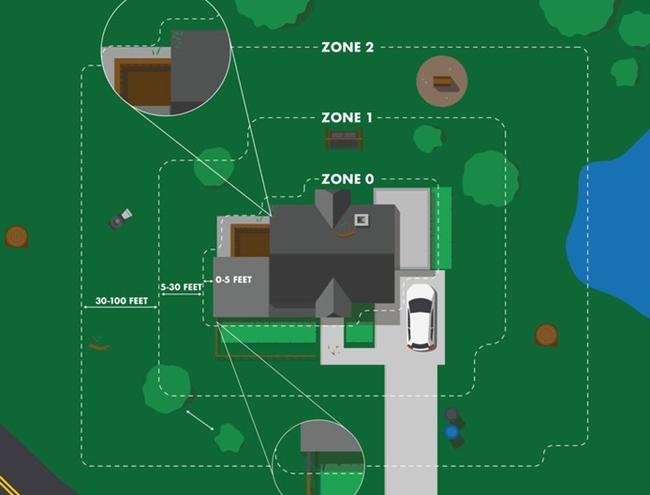
For more information about defensible space https://readyforwildfire.org/prepare-for-wildfire/defensible-space/
Plant spacing of grasses, shrubs, and trees is key in slowing the spread of wildfires. Spacing varies depending on the slope of the land, plant and tree type, and size.
Wildfires travel at different speeds based on many factors, but it is generally true that fire moves up-slope at a fast pace. If your home has a slope down from it, then you will need to pay attention to the spacing of trees and other plants. The steeper the slope, the more generous the spacing needs to be. Note in the sketches below that if there are bushy ‘ladder fuels' under the trees, then the distance is not from one tree trunk to another, but instead from one ‘island' to another.
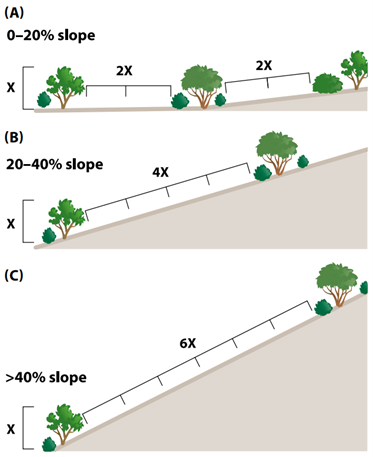
SLOPE & DISTANCE Between Plantings
Vertical spacing
- Trim branches at least 6 feet from the ground.
- Increase vertical space between shrubs and trees to prevent the fire from climbing. For example, a 5-foot shrub near a tree will need 15 feet of clearance to the tree's lowest limbs.
Horizontal spacing
- Is determined by the slope of the land.
- The steeper the slope, the greater the distance between plants/trees. See the illustration on the right.
Plant placement and maintenance are more important than plant attributes, and plant attributes are more important than specific plant species:
As you have seen, Defensible Space is focused on spatial considerations. The specific plants for your Fire-wise garden should be chosen based on their physical characteristics and on the amount of care that you plan to give them. Keeping up with irrigation, pruning, and leaf litter cleanup is essential, even with plants that are less fire prone. All plants can burn, regardless of how they are marketed!
|
Plant attributes: |
Comments: |
|
Does the plant contain a lot of waxes, oils, and resins? |
A plant with more waxes, oils, and resins will likely be more flammable and release more energy when it burns. (Conifers are generally high in resins.) |
|
What is the leaf moisture content? |
Leaves with higher moisture content are less flammable than drier leaves. (See more on succulents below.) |
|
Does the plant have an open-growth structure? |
A densely structured plant can capture embers and may be more likely to ignite. It will also be more likely to be easily ignited by a surface fire. (See the Crape Myrtle example below.) |
|
How fast does the plant grow? How tall will the plant grow? |
A plant that grows quickly may exceed growth expectations and require greater maintenance. Pruning, maintenance, and cleanup can have a greater impact on whether a plant ignites than does the type of plant it is. |
|
Does the plant shed bark, leaves, or needles?
|
A plant that sheds bark or branches is likely to need more regular maintenance-related cleanup to reduce fuel accumulations on the ground. (Example: Eucalypts) A plant that has a big leaf or needle drop will result in the need for more maintenance-related cleanup on the property, on the roof, and in rain gutters. |
|
Is the plant native to the area? |
Native plants, pollinator-friendly, or drought-tolerant plants can be good choices for those labeled qualities, but these features do not directly translate to fire resistance. |
Fire resistant plants.
Labeling any plant as fire-resistant is an oversimplification of a complex problem. There can also be confusion as to whether a plant is resistant (does not easily catch fire) or resilient (has the ability to survive or has seeds that will survive). So, relying on lists of fire-safe plants is not the best thing to do. Below are just a couple of examples of plants that you may find on such lists, with some corresponding comments.
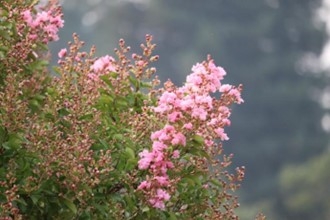
Crape myrtle (Lagerstromia indica)
These beautiful small trees (or bushes) tend to develop suckers that, if not removed, can form a dense cluster. The crowns can become dense, so they require ongoing pruning and thinning. Also, some gardeners like them positioned as hedges, which could cause a fire to travel quickly along the length of the hedge.
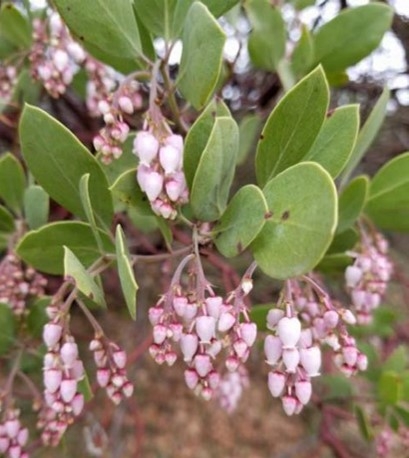
Manzanita (Arctostaphylos spp)
These native plants range from low, spreading plants to large bushes. They have a lot of appeal both because of their flowers and their striking bark. In a garden they are sometimes planted under larger trees, thereby creating a ‘ladder' for a fire to reach the crown of a tree above it. If a manzanita burns, it burns hot, but in the wild they have an amazing ability to re-sprout from the root, making them resilient.
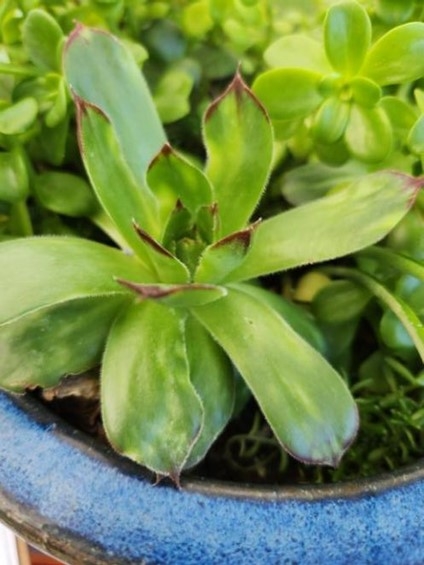
Succulents (numerous genera)
In zone 0, succulents may be a choice for those of us who are not excited about switching to hardscape around the house. There are many varieties of succulents that hug the ground and contain a lot of water in their fleshy leaves. It has been suggested, though the jury is still out on this, that such plants, when well maintained, may actually help keep swirling embers from reaching the base of your house. Sonoma County's Master Gardeners have a great page on succulents: https://sonomamg.ucanr.edu/Recommended_Plants_for_Sonoma_County/Succulents
Coastal wildfire concerns:
The counties of Humboldt and Del Norte are blessed with a long, beautiful coastline with a cool and moist climate, and most of our population lives near the ocean. It is the hotter, forested inland areas that have seen the bulk of the wildfires. However, the coastal communities should not be complacent, as indicated by this snippet (Chapter 14 Wildfire Hum Co-LHMP (ca.gov)):
Despite the generally damp climate prevailing in these forests, studies have suggested a historical fire return interval of 50 to 100 years in the northern part of [Humboldt County] and 12 to 50 years in the south. Several of the more destructive historical fires occurred on the coast around the Trinidad area, including the 7,432-acre Luffenholz Fire of 1908, the 17,527-acre A-Line Fire of 1936, and a 15,000-acre unnamed fire near Patrick's Point in 1945.
Resources:
Much of this article is based on a document from Humboldt/Del Norte's own Yana Valachovic, Forest Advisor for the University of California Cooperative Extension and Humboldt – Del Norte County Advisor and colleagues: Reducing the Vulnerability of Buildings to Wildfire: Vegetation and Landscaping Guidance _UC ANR publication 8695.
CalFire
Defensible Space https://www.fire.ca.gov/dspace and https://readyforwildfire.org/prepare-for-wildfire/defensible-space/